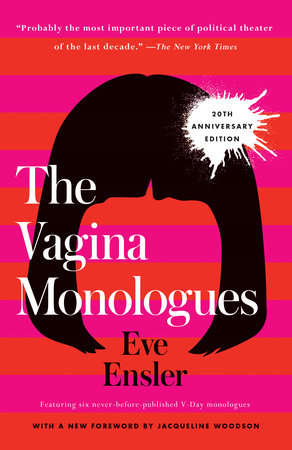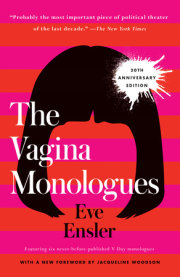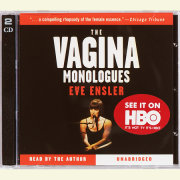FOREWORD
by
Gloria SteinemI come from the "down there" generation. That is, those were the words-spoken rarely and in a hushed voice-that the women in my family used to refer to all female genitalia, internal or external.
It wasn't that they were ignorant of terms like vagina, labia, vulva, or clitoris. On the contrary, they were trained to be teachers and probably had more access to information than most.
It wasn't even that they were unliberated, or "straitlaced," as they would have put it. One grandmother earned money from her strict Protestant church by ghostwriting sermons-of which she didn't believe a word-and then earned more by betting it on horse races. The other was a suffragist, educator, and even an early political candidate, all to the alarm of many in her Jewish community. As for my own mother, she had been a pioneer newspaper reporter years before I was born, and continued to take pride in bringing up her two daughters in a more enlightened way than she had been raised. I don't remember her using any of the slang words that made the female body seem dirty or shameful, and I'm grateful for that. As you'll see in these pages, many daughters grew up with a greater burden.
Nonetheless, I didn't hear words that were accurate, much less prideful. For example, I never once heard the word clitoris. It would be years before I learned that females possessed the only organ in the human body with no function other than to feel pleasure. (If such an organ were unique to the male body, can you imagine how much we would hear about it-and what it would be used to justify?) Thus, whether I was learning to talk, to spell, or to take care of my own body; I was told the name of each of its amazing parts except in one unmentionable area. This left me unprotected against the shaming words and dirty jokes of the school yard and, later, against the popular belief that men, whether as lovers or physicians, knew more about women's bodies than women did.
I first glimpsed the spirit of self-knowledge and freedom that you will find in these pages when I lived in India for a couple of years after college. In Hindu temples and shrines I saw the lingam, an abstract male genital symbol, but I also saw the yoni, a female genital symbol, for the first time: a flowerlike shape, triangle, or double-pointed oval. I was told that thousands of years ago, this symbol had been worshiped as more powerful than its male counterpart, a belief that carried over into Tantrism, whose central tenet is man's inability to reach spiritual fulfillment except through sexual and emotional union with woman's superior spiritual energy. It was a belief so deep and wide that even some of the woman-excluding, monotheistic religions that came later retained it in their traditions, although such beliefs were (and still are) marginalized or denied as heresies by mainstream religious leaders.
For example: Gnostic Christians worshiped Sophia as the female Holy Spirit and considered Mary Magdalene the wisest of Christ's disciples; Tantric Buddhism still teaches that Buddhahood resides in the vulva; the Sufi mystics of Islam believe that fana, or rapture, can be reached only through Fravahi, the female spirit; the Shekina of Jewish mysticism is a version of Shakti, the female soul of God; and even the Catholic church included forms of Mary worship that focused more on the Mother than on the Son. In many countries of Asia, Africa, and other parts of the world where gods are still depicted in female as well as in male forms, altars feature the Jewel in the Lotus and other representations of the Lingam-in-the-yoni. In India, the Hindu goddesses Durga and Kali are embodiments of the yoni powers of birth and death, creation and destruction.
Still, India and yoni worship seemed a long way from American attitudes about women's bodies when I came home. Even the sexual revolution of the 1960s only made more women sexually available to more men. The "no" of the 1950s was just replaced with a constant, eager "yes." It was not until the feminist activism of the 1970s that there began to be alternatives to everything from patriarchal religions to Freud (the distance from A to B), from the double standard of patriarchal/political/religious control over women's bodies as the means of reproduction.
Those early years of discovery are symbolized for me by such sense memories as walking through Judy Chicago's Woman House in Los Angeles, where each room was created by a different woman artist, and where I discovered female symbolism in my own culture for the first time. (For example, the shape we call a heart-whose symmetry resembles the vulva far more than the asymmetry of the organ that shares its name-is probably a residual female genital symbol. It was reduced from power to romance by centuries of male dominance.) Or sitting in a New York coffee shop with Betty Dodson (you will meet her in these pages), trying to act cool while she electrified eavesdroppers with her cheerful explanation of masturbation as a liberating force. Or coming back to Ms. magazine to find, among the always humorous signs on its bulletin board: IT'S 10 O'CLOCK AT NIGHT-DO YOU KNOW WHERE YOUR CLITORIS IS?
By the time feminists were putting CUNT POWER! on buttons and T-shirts as a way of reclaiming that devalued word, I could recognize the restoration of an ancient power. After all, the Indo-European word cunt was derived from the goddess K ali's title of Kunda or Cunti, and shares the same root as kin and country.
These last three decades of feminism were also marked by a deep anger as the truth of violence against the female body was revealed, whether it took the form of rape, childhood sexual abuse, anti-lesbian violence, physical abuse of women, sexual harassment, terrorism against reproductive freedom, or the international crime of female genital mutilation. Women's sanity was saved by bringing these hidden experiences into the open, naming them, and turning our rage into positive action to reduce and heal violence. Part of the tidal wave of creativity that has resulted from this energy of truth telling is this play and book.
When I first went to see Eve Ensler perform the intimate narratives in these pages-gathered from more than two hundred interviews and then turned into poetry for the theater-I thought: I already know this: it's the journey of truth telling we've been on for the past three decades. And it is. Women have entrusted her with their most intimate experiences, from sex to birthing, from the undeclared war against women to the new freedom of love between women. On every page, there is the power of saying the unsayable-as there is in the behind-the-scenes story of the book itself. One publisher paid an advance for it, then, on sober second thought, allowed Eve Ensler to keep the money if she would take the book and its v-word elsewhere. (Thank Villard for publishing all of women's words-even in the title.)
But the value of
The Vagina Monologues goes beyond purging a past full of negative attitudes. It offers a personal, grounded-in-the-body way of moving toward the future. I think readers, men as well as women, may emerge from these pages not only feeling more free within themselves-and about each other-but with alternatives to the old patriarchal dualism of feminine/masculine, body/ mind, and sexual/spiritual that is rooted in the division of our physical selves into "the part we talk about" and "the part we don't."
If a book with vagina in the title still seems a long way from such questions of philosophy and politics, I offer one more of my belated discoveries.
In the 1970s, while researching in the Library of Congress, I found an obscure history of religious architecture that assumed a fact as if it were common knowledge: the traditional design of most patriarchal buildings of worship imitates the female body. Thus, there is an outer and inner entrance, labia majora and labia minora; a central vaginal aisle toward the altar; two curved ovarian structures on either side; and then in the sacred center, the altar or womb, where the miracle takes place-where males give birth.
Though this comparison was new to me, it struck home like a rock down a well. Of course, I thought. The central ceremony of patriarchal religions is one in which men take over the yoni-power of creation by giving birth symbolically. No wonder male religious leaders so often say that humans were born in sin-because we were born to female creatures. Only by obeying the rules of the patriarchy can we be reborn through men. No wonder priests and ministers in skirts sprinkle imitation birth-fluid over our heads, give us new names, and promise rebirth into everlasting life. No wonder the male priesthood tries to keep women away from the altar, just as women are kept away from control of our own powers of reproduction. Symbolic or real, it's all devoted to controlling the power that resides in the female body.
Since then, I've never felt the same estrangement when entering a patriarchal religious structure. Instead, I walk down the vaginal aisle, plotting to take back the altar with priests-female as well as male-who would not disparage female sexuality, to universalize the male-only myths of Creation, to multiply spiritual words and symbols, and to restore the spirit of God in all living things.
If overthrowing some five thousand years of patriarchy seems like a big order, just focus on celebrating each self-respecting step along the way.
I thought of this while watching little girls drawing hearts in their notebooks, even dotting their i's with hearts, and I wondered: Were they magnetized by this primordial shape because it was so like their own bodies? I thought of it again while listening to a group of twenty or so diverse nine- to sixteen-year-old girls as they decided to come up with a collective word that included everything-vagina, labia, clitoris. After much discussion, "power bundle" was their favorite. More important, the discussion was carried on with shouts and laughter. I thought: What a long and blessed way from a hushed "down there."
I wish my own foremothers had known their bodies were sacred. With the help of outrageous voices and honest words like those in this book, I believe the grandmothers, mothers, and daughters of the future will heal their selves-and mend the world.
. All rights reserved. No part of this excerpt may be reproduced or reprinted without permission in writing from the publisher.










